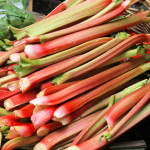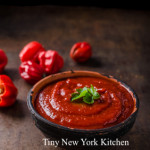Crunchy, juicy, nutrient packed jicama is an unsung hero of the produce aisle. Technically a cousin to green beans, jicama is a root vegetable from Mexico available year-round that is delicious cooked or raw. With a mild, earthy, slightly sweet flavor and an apple like consistency. It’s a great addition to salads, salsas, slaws, and grazing boards. Jicama also works as lighter swap for potatoes in baked and air fried recipes, and it’s delicious sautéed or boiled, too.
If you’ve never tried jicama, don’t be intimidated. Start by choosing one with a smooth, unblemished surface and thin brown skin. The skin should be thin enough to scrape with your thumbnail to reveal the white flesh inside. Avoid thick skinned, bruised, or shriveled jicama, which are signs of aging.
Once you’re ready to prep, start by trimming off the ends of the jicama and slice in half. Then, use a knife to gently peel away the skin.
For Jicama Sticks:
Step 1: Carefully slice off the rounded parts of the jicama, creating a flat surface.
Step 2: Cut each half into 1/4-inch slices.
Step 3: Stack slices and cut evenly into sticks.
Fresh, raw jicama sticks are a great addition to lunchboxes or served on a vegetable platter with your favorite dip. They can also add unexpected, satisfying crunch to cooked dishes, like a noodle salad with jicama and a miso vinaigrette.
Jicama sticks are delicious roasted, too. Their firm texture can withstand the heat, while the edges get golden brown and tender. Toss together with sweet peppers and spices for a simple, satisfying sheet pan side that pairs well with all kinds of meat and fish.
For Diced Jicama:
Step 1: Follow the steps above to create jicama sticks
Step 2: Line up sticks or stack into a pile, then evenly cut into cubes.
Diced jicama is a vitamin and fiber-rich way to add bulk to all kinds of green, grain, and protein-based salads. I love the combination of crunchy jicama with creamy avocado served with grilled chicken.
Moist and mild flavored jicama also plays well with fruit, especially melon. A refreshing combination of watermelon, jicama, and fresh mint falls somewhere between salad and salsa, delicious scooped onto tortilla chips or just spooned straight from the bowl.
Next time you’re at your local grocery store or market pick up jicama and experiment with ways to incorporate it into your recipes.
©Tiny New York Kitchen © 2021 All Rights Reserved
These freezer essentials will help you with your weekly meal prep as well as last minute meals that you need to get on the table fast.
Bagged frozen vegetables, like mixed peppers, broccoli, and spinach.
Bagged frozen fruit, like blueberries, mangos, bananas, and strawberries.
Bagged frozen pastas, like tortellini and ravioli.
Frozen waffles and pancakes.
Frozen potatoes, like tots, fries, and breakfast potatoes.
Rice and prepared side dishes.
Pre-made dough, pie crusts, and breads.
Frozen foods are not limited to frozen dinners. You can stock your freezer with healthier ingredients to make putting dinner together easy. There are endless possibilities with what you can make with frozen ingredients. As always, be creative and “work with what you got!”
“Work With What You Got!”
©Tiny New York Kitchen © 2020 All Rights Reserved
Fire things up with popular hot sauces. Whether you’re just starting to heat things up or you’re looking for new options there’s a sauce to spice up any meal.
HARISSA
This thick North African sauce combines hot peppers with garlic and other seasonings. It’s traditionally served with couscous, but harissa can also add flavor and fire to everything from meat and fish to vegetables and eggs.
SRIRACHA
While there is sriracha from Thailand (it’s named after the town where it was created in the 1930s), the wildly popular one used in everything from wings to Bloody Marys is produced in Southern California. Both feature fresh red chilies, sugar, salt, garlic, and vinegar.
GREEN HOT SAUCE
Most hot sauces are red because they’re made with red peppers, but there are green versions, which are typically made with jalapeños and/or poblanos and sometimes tomatillos. Green sauces can be milder or more herbal, but heat levels vary from sauce to sauce.
LOUISIANA STYLE
Most hot sauces are based on the Louisiana style formula of chilies, vinegar, and salt, and puréed into a thin red liquid. Which peppers are used, how they’re processed, and additional ingredients make for endless variety.
MEXICAN HOT SAUCE
South-of-the-border sauces tend to use the same Louisiana style combination of chilies, vinegar, and salt, and have a similar flavor, but if you’re eating tacos, why not reach for a bottle from Mexico? Many include chipotles, which are dried and smoked jalapeños, and add smoky flavor.
“Work With What You Got!”
©Tiny New York Kitchen © 2019 All Rights Reserved
Eating well just got easier. Use one or more ingredients from each of the five categories. Stick with one international flavor profile. Find a sauce in your market’s global-foods section: ssamjang, chutney, hot sauce, salsa, pesto, chimichurri, romesco, aioli, tahini, or peanut sauce. Save money by using leftovers. Save time by using prechopped fresh vegetables.
CHOOSE A BASE INGREDIENT
1/2 Cup
Cooked Brown Rice, Quinoa, Millet, Bulgur, Farro, Barley, Whole Grain Pasta
CHOOSE A LEAN PROTEIN
3 To 4 Ounces
Cooked Meat, Poultry, Seafood, Legumes, Eggs, Tofu
CHOOSE VEGETABLES
1 To 2 Cups
Vary Colors And Textures
CHOOSE A SAUCE
1 To 3 Tablespoons
Sriracha, Harissa, Soy, Sweet Chili, Ssamjang, Chutney, Hot Sauce, Salsa, Pesto, Chimichurri, Romesco, Aioli, Tahini, Peanut Sauce
Bowl Ideas
Korean: Cooked noodles or rice, shredded carrot, sliced cucumber, sliced daikon radish, bean sprouts, sliced grilled beef, runny fried egg, ssamjang, kimchi
Middle Eastern: Cooked bulgur, roasted eggplant, roasted cauliflower, sautéed spinach, cooked chickpeas, grilled chicken, minted yogurt sauce, roasted pumpkin seeds, za’atar spice blend
Italian: Cooked faro, sautéed zucchini, sautéed kale, roasted red peppers, roasted cherry tomatoes, tuna, pesto, olives, marinated artichoke hearts, pine nuts
“Work With What You Got!”
©Tiny New York Kitchen © 2019 All Rights Reserved
We’re coming to the end of the last wave of beautiful warm weather. It’s a perfect time to take advantage of wonderful days and delicious late summer crops. Farmers’ markets are bursting with baskets of delectable produce that can be preserved in many ways. If you have plenty of peppers they can be roasted in the oven or grilled to get that fabulous smokiness to both sweet and hot varieties. Whichever method of heat you choose, continually turn peppers until they are blackened on all sides. Place the charred peppers into a paper bag and let them steam for at least thirty minutes. When cooked, remove the skins with a gentle rubbing motion, slice the peppers into strips, remove the ribs and seeds, and place the strips in small freezer containers. To each container add several peeled garlic cloves, fresh basil, oregano, and thyme. Cover with olive oil. Cover containers and let the peppers infuse on your countertop for a day. Store in the refrigerator for up to a week or place in the freezer to use over the winter months. Use the smoky, sweet strips to enliven a winter antipasto, add rich flavor to sandwiches or crostini or a vibrant soup that will remind you of summer.
“Work With What You Got!”
© Victoria Hart Glavin Tiny New York Kitchen © 2017 All Rights Reserved
September
September is a wonderful time for enjoying the beautiful array at local farmers’ markets. September is a delightful time for gathering ingredients that will showcase fleeting flavors of summer. A walk among colorful baskets filled with fresh produce is incredibly inspiration.
Blazing scarlet tomatoes, sun-sweetened and fattened from their time on the vine, are joined by zesty green, bright yellow, and almost purple-colored varieties. Turn this beautiful rainbow into a final summer tomato salad by simply cutting thick slices of each colorful variety of tomato, and arranging them on a big platter. Drizzle the slices with olive oil and balsamic vinegar, sprinkle with a bit of sea salt, and finish the dish with finely minced basil.
Fill your shopping cart with crisp cucumbers, glossy purple or creamy white eggplant, pale green or buttery yellow summer squashes, string or wax beans, spicy jalapeno peppers, fragrant peaches, lush melons, sugary corn on the cob and great bunches of finely scented fresh herbs.
As September evenings grow quietly cooler, take pleasure in preparing dishes that feature these ingredients, such as nutmeg-scented roasted peaches, a delectable eggplant parmesan, velvety corn soup, garlic string beans or summer squash stuffed with ground lamb or turkey, breadcrumbs, fresh basil, oregano and parsley, cinnamon and bit of cheese. Cucumbers can be turned into simple refrigerator pickles, jalapeños can be roasted on the grill and packed away in the freezer, ensuring that a bit of summer will still be served as the season marches on.
There is also a hint of fall to be found at the farmers’ market. While all of the summer crops are still available to be savored, the new season is sneaking in. Freshly dug potatoes, dark purple plums, crisp early apples, succulent pears, Brussels sprouts, earthy mushrooms, carrots, cauliflower and kale will provide culinary creativity for weeks to come.
Cooking and eating with the seasons is the most excellent and efficient way to introduce high quality nutrients into the body. When we enjoy what nature has prepared for us, we are giving our bodies the gift of exceptionally luscious flavor, along with important healing properties. I can’t think of a better way to prepare a delicious life.
www.tinynewyorkkitchen.com
“Work With What You Got!”
© Victoria Hart Glavin Tiny New York Kitchen © 2016 All Rights Reserved
Bell Pepper Basics
Bell peppers are also called sweet peppers. They are not hot in flavor and come in lots of colors. Bell peppers are an excellent source of vitamin C & B6.
Green: Most common and less sweet than others.
Red: Fully ripe green peppers turn red and are sweeter than green. Green bell peppers cost less and store longer than other types.
Yellow and Orange: Bright in color with a mildly sweet fruity flavor.
Purple, White or Brow: May be available from farmers’ markets or by growing your own.
Choose bell peppers that are firm and heavy for their size with bright coloring and glossy skin. If stems are still attached they should be firm and green.
Fresh peppers are more available and tastier while in-season during the summer and early fall.
Avoid peppers that have thin wrinkled skin or brown patches.
Buy only what you will use within a week or plan to freeze extras for future use.
Keep bell peppers fresh by washing just before serving.
Cutting bell pepper: After washing, cut off stems and cut peppers in half – lengthwise or crosswise. Remove seeds and the white membrane from the inside. Cut peppers into rings, strips or dice them into squares. Cut peppers can be stored, covered, for 2 days in the refrigerator.
Whole peppers can be stored in the refrigerator for up to 5 days. They are easy to freeze for longer storage. No blanching is needed. Place peppers in freezer bags or containers. Seal and label with the date. Frozen peppers should be used within 8 months.
“Work With What You Got!”
© Victoria Hart Glavin Tiny New York Kitchen © 2015 All Rights Reserved















